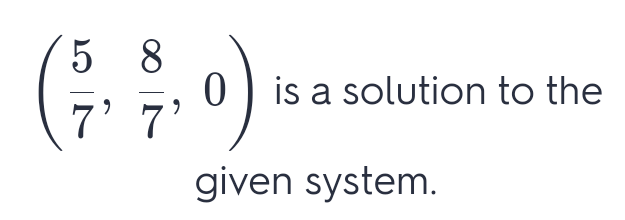Elementary Linear algebra
Chapter 1.1
Exercise 10
(a)
(b)
To determine whether the given 3-tuple is a solution, we will substitute it in place of variables x, y and z and see it satisfies each of the three equations.
Substitute (75, 78, 0) into the first equation:
75+2⋅78−2⋅0=75+716=721=3
Substitute (75, 78, 0) into the second equation:
3⋅75−78+0=715−78=77=1
Substitute (75, 78, 0) into the third equation:
−75+5⋅78−5⋅0=−75+740=735=5
All three equations are satisfied, hence (75, 78, 0) is a solution to the given system.
(c)
To determine whether the given 3-tuple is a solution, we will substitute it in place of variables x, y and z and see it satisfies each of the three equations.
Substitute (5, 8, 1) into the first equation:
5+2⋅8−2⋅1=5+16−2=19=3
The given 3-tuple does not satisfy the first equation hence it is not the solution to the system.
(d)
To determine whether the given 3-tuple is a solution, we will substitute it in place of variables x, y and z and see it satisfies each of the three equations.
Substitute (75, 710, 72) into the first equation:
75+2⋅710−2⋅72=75+720−74=721=3
Substitute (75, 710, 72) into the second equation:
3⋅75−710+72=715−710+72=77=1
Substitute (75, 710, 72) into the third equation:
−75+5⋅710−5⋅72=−75+750−710=735=5
All three equations are satisfied, hence (75, 78, 72) is a solution to the given system.
(e)
To determine whether the given 3-tuple is a solution, we will substitute it in place of variables x, y and z and see it satisfies each of the three equations.
Substitute (75, 722, 2) into the first equation:
75+2⋅722−2⋅2=75+744−2=749−2=3
Substitute (75, 722, 2) into the second equation:
3⋅75−722+2=715−722+2=−1+2=1
Substitute (75, 722, 2) into the third equation:
−75+5⋅722−5⋅2=−75+7110−10=7105−10=5
All three equations are satisfied, hence (75, 722, 2) is a solution to the given system.




















